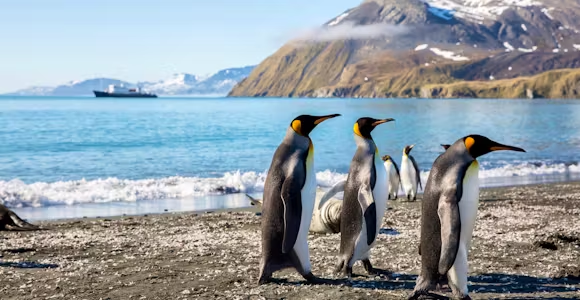
South Georgia Wildlife
Numbers alone simply can’t explain how extraordinarily abundant and breathtaking the wildlife of South Georgia is: this is the Serengeti of the Southern Ocean
Discover More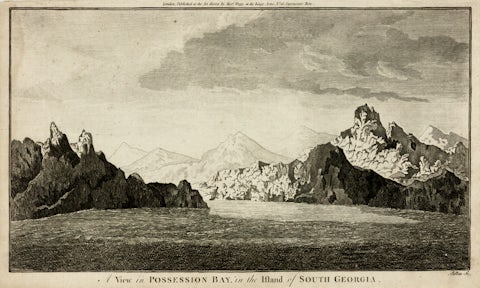
The first image of South Georgia, engraved in 1775 following Cook's voyage
South Georgia was the first land to be discovered south of the Antarctic Converge, where the cold polar seas meet the southern Atlantic. The honour of its first sighting is given to Antoine de la Roché, a London merchant whose ship was blown off course when sailing from Peru to Hamburg in 1675. It took another century for anyone to step foot on the island.
On 17 January 1775, a shore party led by Captain James Cook in command of HMS Resolution made their first landing here. To a volley of gunshots witnessed by an audience of penguins and seals, he claimed ownership in the name of the British Crown in the appropriately named Possession Bay, now known as Prince Olav Harbour.
Cook's men found South Georgia a 'savage and horrible' place impossible for settlement: the expedition naturalist suggested that such a desolate place could only find use as a penal colony.
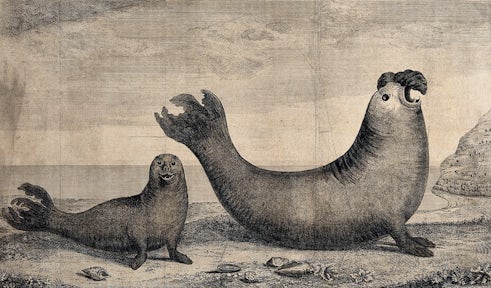
19th century engraving of elephant seals in the Southern Ocean
Captain Cook's reports on South Georgia's wildlife were seized upon by one group: sealers. The first recorded sealing expedition was made in 1786 and showed there were rich profits to be made from the island. American sealing ships were particularly active, shipping fur seal pelts to be sold in China. Elephant seals were also hunted for the valuable oil in their blubber.
The work was hard and bloody for the men but they were brutally effective in their work. When the explorer James Weddell visited South Georgia in 1823 he noted that at least 1.2 million fur seal skins had been exported from the island. In less than 50 years the fur seal was driven virtually to extinction.
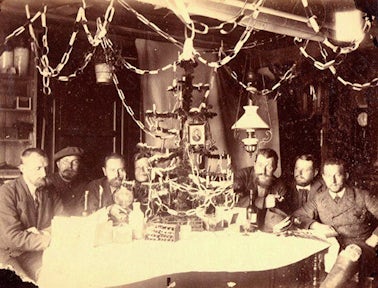
The German expedition of 1882/3 celebrate Christmas on South Georgia
In 1843 Great Britain formally established its governance over South Georgia, overseeing it from the Falkland Islands. Sealing for oil continued intermittently throughout this period. In 1882/3, an expedition of German scientists spent a year living on South Georgia carrying out the first sustained exploration of the island as part of the International Polar Year.
Attempts were made to grow potatoes, wheat and barley in the semi-frozen, and cows, sheep and goats were introduced. None of these introductions lasted, but two other species – rats and mice from the sealing ships would go on to have a devastating effect on South Georgia's wildlife

Processing whales in South Georgia during the First World War
In 1894 the Norwegian Carl Anton Larson had seen huge numbers of whales in the seas around South Georgia, and ten years later brought three ships to the island to establish a whaling station in Grytviken. The first whale was processed on 24 December 1904, kickstarting the Antarctic whaling industry. Six shore-based whaling stations were established in quick succession at Grytviken, Godthul, Leith Harbour, Husvik, Stromness Harbour and Prince Olav Harbour. Reindeer were introduced to provide an extra food source for the whalers.
The easy to catch humpback whales were quickly fished out to the point of commercial extinction, so the whalers moved on to other species. In in the peak season of 1925/26, 7825 mostly blue and fin whales were killed, and reduced to 404,500 barrels of oil. Overproduction was such that in 1931 most whaling stations were forced to close for a year, with further respite coming when ships were pressed into service during the Second World War.
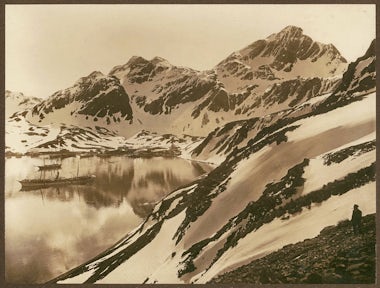
Grytviken harbour, photographed by Frank Hurley of the Endurance expedition
In 1914 South Georgia received its most famous visitor, the celebrated polar explorer Sir Ernest Shackleton, who was planning to embark on the first crossing of Antarctica. The whalers at Grytviken warned him that the sea ice that season was too severe to make a landing on the continent: a lesson he only learned when Endurance sank after being crushed by the pack in the Weddell Sea.
After his men took shelter on Elephant Island, Shackleton made the almost unbelievable 800 voyage to South Georgia in the tiny James Caird lifeboat, then walked across the unmapped interior to raise the alarm at Stromness whaling station.
In 1922 Shackleton returned on the Quest expedition but died of a heart attack in Grytviken, where he was buried in the whaler's cemetery.
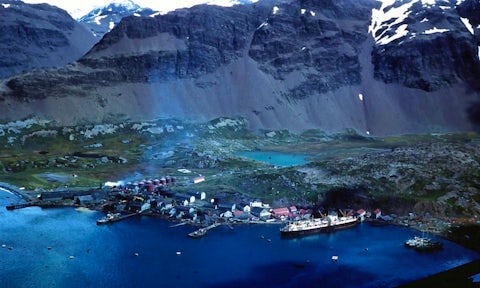
The whaling station at Leith Harbour in its final years of operation
South Georgia's whaling industry finally shudders to a halt, as production moves offshore onto roving factory vessels supported by fleets of catcher ships that can penetrate farther into Antarctic waters. Grytviken closes in 1964, with the largest operation at Leith Harbour shutting down the following year. The whaling companies abandon the stations in near-perfect working order, expecting to eventually return. They never do. Over the 61 years of whaling at South Georgia, 175,020 whales were killed in its waters.
In 1969 South Georgia becomes a home for science when the British Antarctic Survey starts operating from a new base at King Edward Point.

British Royal Marines on patrol in Grytviken
On 3 April 1982 South Georgia is occupied by Argentinian soldiers at the start of the Falklands conflict, with British Antarctic Survey staff taken prisoner. The island was recaptured by British forces after three weeks, and is garrisoned by the British Army for the next 19 years.
Civilian administration returns in 1990, with the island having been declared a British Overseas Territory five years earlier.
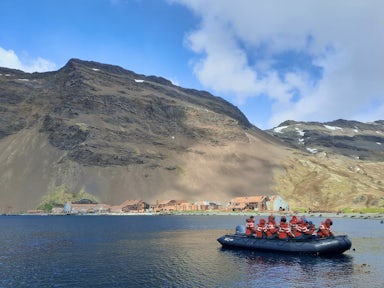
Expedition cruise passengers zodiac cruising near the ruins of Stromness whaling station
The museum in Grytviken opens its doors to the first expedition cruise ship passengers in 1992, followed by a major environmental clean-up to remove unsafe buildings. In 2012 one of the world’s largest Marine Protected Areas is declared in South Georgia's, covering nearly 500 square miles.
In 2013, the South Georgia Heritage Trust launches an ambitious project to eradicate rodents from the island. After five years South Georgia is declared rodent-free. Species like the South Georgia pipit return from their strongholds on outlying islands to recolonise the mainland. By 2020, the humpback whale population is deemed to have returned to its pre-whaling population numbers.
Price Match Promise - We’ll match any price you find elsewhere for the same trip

Numbers alone simply can’t explain how extraordinarily abundant and breathtaking the wildlife of South Georgia is: this is the Serengeti of the Southern Ocean
Discover More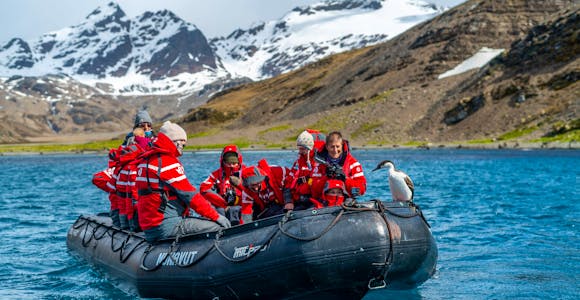
Walk across South Georgia's spectacular landscape, go ashore to meet the abundant wildlife or learn about the island's rich history.
Discover More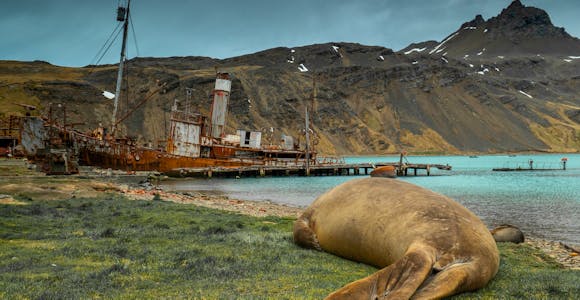
Raise a toast to Shackleton and walk around the rusting ruins of the old whaling station at Grytviken, the historic heart of South Georgia.
Discover More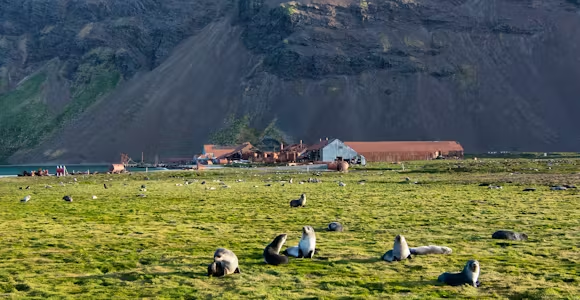
Stromness is where Shackleton arrived at the end of his epic trek across South Georgia and remains the terminus for a popular hike from Fortuna Bay.
Discover MoreWe'll spend some time listening to your aspirations, then discuss the kind of experience that might suit you.
Next we'll discuss the options, shortlist the best trips for you and present you our impartial recommendations.
We'll place a 24 hour hold on your preferred option - without obligation - whilst we talk through the details.